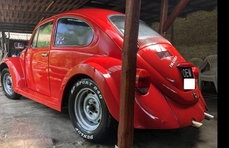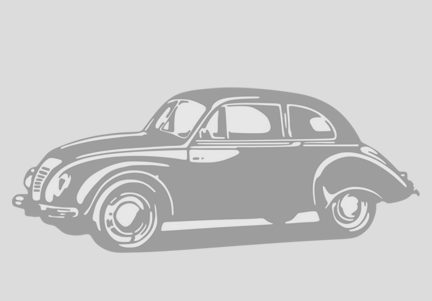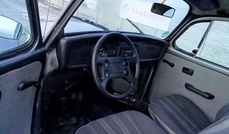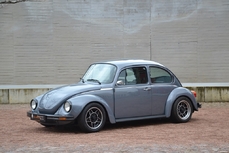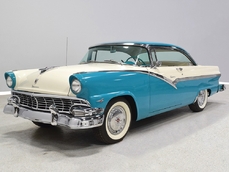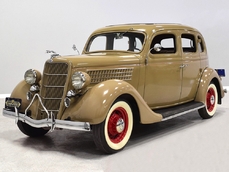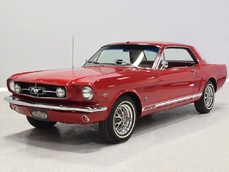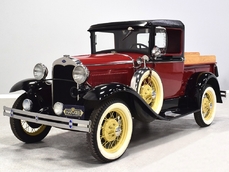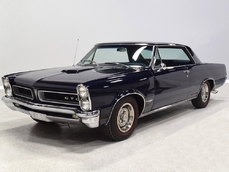Volkswagen 1303 1585 cc air-cooled flat-4 1972
Allgemeine Beschreibung :
The first question everyone asks about this incredible Super Beetle is: why so few miles (1786, which is a true reading)?
Well, the story goes like this: Christmas Eve 1971, Hans Hermann of Dayton, Ohio bought this bright little Beetle as a Christmas gift for his 17-year-old daughter. Unfortunately, Mr. Hermann never thought about the fact that the Beetle only had a manual transmission, and his daughter did not know how to drive a 4-speed. Apparently she had no desire to learn, but was simultaneously unwilling to part with the cute little car because it was a gift. So it remained in the Herrmann family until 1998 when a neighbor, Arthur Enyart, who had long known about the immaculately preserved old Beetle, was finally able to convince the Hermanns to part with it. At that point, it had just 1036 original miles. In November 2005, Mr. Enyart sold it to a gentleman in Missouri with 1049 miles on the clock, and the fourth and most recent owner purchased it in 2019 with 1776 original miles.
It seems that after a certain point, driving this remarkable specimen seemed like the wrong thing to do, so it remains extremely well preserved and in entirely original condition. The paint is factory code L30B, “Kasan Red,” and it remains in fantastic shape—say what you want about Beetles being cheap, but it certainly was not reflected in the quality of their construction. There’s still a great shine to the finish, zero evidence of rust or accident repair, and as always, original paint means no nasty surprises hiding underneath. As you would expect, panel gaps are exemplary and the doors close with a remarkably solid-sounding THUD. 1972 was the final year of flat windshields and small taillights on the Beetle, so it has a delightful old Beetle look, and even the headlights are original. You’ll also note that the chrome and stainless trim is original, and aside from some very minor signs of age on the bumpers, it’s excellent throughout. Although there are a few extremely minor signs of age (light polishing marks, primarily), this is surely as close to a new 1972 Volkswagen as you will find.
The black leatherette interior (which was actually optional) is likewise as new with extremely crisp detailing on the seats that reproduction seat covers can’t quite match. Carpets, door panels, and the dash pad are in as-new condition and it’s obvious that this car has never been stored outdoors or in the sun. Controls are simple and options are few, but they all work, including the factory-installed AM radio in the center of the dash. The seat belts might look curious to some onlookers, but we have verified that they are correct and original to the car. The headliner is bright and clean and aside from some a little discoloration at one of the seams (probably glue from the original installation) it, too, is as new. Rubber floor mats have protected the carpets from new and all the weather seals remain supple so it seals up quite well. The forward trunk is beautifully detailed with a correct rubber mat, under which you will find the original never-used spare tire whose air is used to power the windshield washer system.
The engine is the original 1585 cc air-cooled flat-four and it can serve as a blueprint for future restorers. Every clip, every hose, every marking is completely intact making it an accurate representation of how this car looked when it was new. The gold cadmium plating on the various components is still bright, the distinctive Bosch ignition components look like new, and all the heater ducts are in place—that alone should be worth studying by someone putting their own car back together. It also runs like new, starting easily and making those distinctive VW sounds. It has been correctly maintained all its life, with fluid changes at appropriate intervals, but we suspect that even the air filter inside that metal housing is original to the car. It doesn’t need anything serviced to be driven immediately, but you and I both know long drives aren’t in this particular Beetle’s future.
Underneath, it is likewise beautifully preserved and entirely original. The pans are excellent with a light dusting of dealer-applied undercoating and the hardware is largely as the factory intended. There’s some surface scale on the heavy metal parts and exhaust system, but that was likely there moments after it came off the boat in Toledo, Ohio in late 1971. Obviously rust is a non-issue on a car like this and while the components are original, none of them are deteriorated or in need of replacement. You will note original factory markings on the brake and suspension components, original cotter pins in the steering linkage (note to restorers: the pins’ legs are bent to either side, locking on the flats of the nuts), and factory flex tubing for the heater. Original 15-inch steel wheels are unmarked and carry original hubcaps and factory-installed 5.60-15 Continental tires which are fast approaching their 50th birthday.
Documentation includes the window sticker, a complete set of manuals, title history (with a series of ACTUAL MILEAGE titles), brochures, receipts, and more. It also includes a full tool roll and a set of accessory wheel trim rings that have never been installed.
Remarkable survivors like this with extraordinarily low mileage are always exciting finds. The opportunity to study their factory details, the remarkable chain of loving owners, and the window into exactly what these cars were like nearly 50 years ago make this Super Beetle a wonderful find for the dedicated VW enthusiast. Other super low mileage Beetles have already changed hands for considerably more than we’re asking for this one, suggesting that serious collectors prize authenticity above almost everything else. Highly correct, beautifully preserved, and offering an appealing combination of great history and bright color, this is an opportunity to own a genuinely special Beetle. Call today!
Harwood Motors always recommends and welcomes personal or professional inspections of any car in our inventory.
http://www.harwoodmotors.com/vehicles/inventory_details.php?id=1187
1972 Volkswagen 1303 1585 cc air-cooled flat-4 is listed verkauft on ClassicDigest in Macedonia by for $27900.
Fakten der Auto
Karosserietyp : Auto Marke : Volkswagen Modell : 1303 Ausführung : 1585 cc air-cooled flat-4 Hubraum : 0.0 Modelljahr : 1972 Lage : Ohio
Verkauft
Angaben Zum Verkäufer
Verkauft
People who viewed this Volkswagen 1303 also viewed similar Volkswagen listed at ClassicDigest
Other cars listed for sale by this dealer
über Volkswagen
Die Volkswagen-Geschichte ist in der Tat eine faszinierende Geschichte von Innovation, Belastbarkeit und Wiederbelebung nach dem Krieg, die von verschiedenen Modellen gekennzeichnet ist, die in der Automobilgeschichte zu Ikone geworden sind.Das Volksauto (Volkswagen): Zunächst von Adolf Hitler in den 1930er Jahren als "Volksauto" oder "Volkswagen" auf Deutsch vorgestellt, war die Idee, ein erschwingliches und praktisches Fahrzeug für das deutsche Volk zu schaffen. Dieses Konzept führte zur Entwicklung des von Ferdinand Porsche entworfenen Volkswagenkäfers (oder des Typ 1).
Nachkriegsherausforderungen: Nach dem Zweiten Weltkrieg stand Volkswagen erhebliche Herausforderungen. Die Fabrik war stark beschädigt, und die Verbindung der Marke mit dem NS -Regime führte in einigen Regionen zu einem mangelnden Interesse an dem Auto.
Britische Intervention - Die britische Armee & Ivan Hirst: Die britische Armee übernahm die Kontrolle über die Fabrik in der unmittelbaren Nachkriegszeit. Major Ivan Hirst, ein Offizier der britischen Armee, spielte eine entscheidende Rolle bei der Wiederbelebung von Volkswagen. Er erkannte das Potenzial des Käfers und setzte sich für seine Produktion ein. Er überzeugte das britische Militär, mehrere tausend Autos zu bestellen. Diese Entscheidung hat dazu beigetragen, die Wiederbelebung der Marke zu starten.
Exporterfolg und der globale Anziehungskraft des Käfers: Der Käfer gewann nicht nur in Deutschland, sondern auch weltweit an Popularität und wurde zu einer Ikone des erschwinglichen Fahrwerks. Das einfache, zuverlässige Design und das einzigartige Erscheinungsbild machten es zu einem Favoriten unter den Verbrauchern weltweit.
Modellentwicklung: Im Laufe der Jahre führte Volkswagen verschiedene Modelle neben dem Käfer ein, wobei jeder zum Wachstum der Marke beitrug:
Typ 2 (VW -Bus oder Transporter): In den 1950er Jahren wurde er in den 1960er Jahren zu einem ikonischen Symbol der Hippie -Bewegung eingeführt und wurde wegen seiner Geräumigkeit und Vielseitigkeit geliebt.
Golf (Kaninchen in den USA): Der Golf (oder Kaninchen in den USA) wurde Mitte der 1970er Jahre ins Leben gerufen und markierte eine Verlagerung in Richtung Frontantrieb, modernes Design und Schrägheckpraktikabilität und wurde zu einem Eckpfeiler des Erfolgs der Marke.
Passat, Jetta und andere Modelle: Volkswagen erweiterte seine Aufstellung mit Modellen wie dem Passat und Jetta, die sich für verschiedene Marktsegmente befassen.
Herausforderungen und Innovationen: Trotz des Erfolgs stand Volkswagen vor Herausforderungen, einschließlich Qualitätsproblemen in den 1970er Jahren. Die Marke hat jedoch weiterhin neue Modelle und Technologien entwickelt und entwickelt.
Aufstieg des GTI und globaler Expansion: In den 1980er Jahren stieg der legendäre Golf GTI auf, eine Hochleistungsversion, die den Trend der heißen Luke auslöste. Volkswagen erweiterte auch seine globale Präsenz in diesem Zeitraum.
Die britische Intervention bei der Wiederbelebung von Volkswagen nach dem Zweiten Weltkrieg spielte eine entscheidende Rolle bei der Wiederbelebung der Marke. Während es in den 1950er und 1960er Jahren aufgrund des Erfolgs von Volkswagen in den 1950er und 1960er Jahren möglicherweise einige Spannungen oder einen Wettbewerb zwischen Automobilunternehmen gegeben hat, hat die Fähigkeit der Marke, innovative und beliebte Modelle zu produzieren, ihren Platz in der Automobilgeschichte festigend.



